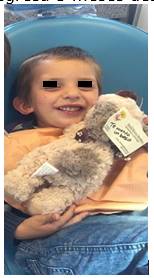Abstract
This work aims to report an individualized, inclusive and humanized dental approach, emphasizing the importance of treating a child of 4 years and three months, with a diagnosis of neurofibromatosis type 1, who was referred and treated at the clinic of the Specialization Course in Pediatric Dentistry of the Graduate School, Faculty of Dentistry, University of the Republic in the city of Montevideo, Uruguay. The clinical examination revealed scars from the surgical treatment of the plexiform neurofibroma affecting the child's neck and oral muscle hypotonicity. At intraoral clinical examination, fifteen deciduous teeth were absent and five with early childhood caries lesions as well as a generalized presence of microbial biofilm on the tooth surfaces and provoked gingival bleeding. A necessary dental treatment was carried out for the patient, with the pertinent care, and rehabilitative therapy with an upper and lower removable partial denture. We conclude that educational, preventive, restorative and rehabilitative dental treatment was satisfactory and empathy, as a dynamic process, involved cognitive, affective and behavioral mechanisms and was recognized for its positive effects in promoting the patient's oral health.
References
2. Gonzalo M. Neurofibromatosis tipo 1: análisis de características clínicas y tipo de complicaciones en pacientes asistidos en un Hospital de referencia nacional [Monografía de posgrado en Pediatría]. [Montevideo]: Universidad de la Republica, UdelaR; 2015. 20p.
3. Souza JF, Toledo LL, FerreIra MCM, RodrIgues LOCR, Rezende MA. Neurofibromatose Tipo 1: mais comum e grave do que se imagina. Rev Assoc Med Bras 2009;55(4):394-9. doi: https://doi.org/10.1590/S0104-42302009000400012.
4. Serna FLD, Usuga OAR. Neurofibromatosis:Reporte de un Caso. Rev Fac Odontol Univ Antioq. 2010 [Fecha de acceso: 29 de julio de 2021];21(2):218-225 Disponible en: http://www.scielo.org.co/pdf/rfoua/v21n2/v21n2a10.pdf
5. Sanabria CR, Hernández GAM. Neurofibromatosis Tipo 1 Enfermedad de Von Recklinghausen. Revista Médica de Costa Rica Centroamérica, San José. 2014 [Fecha de acceso: 29 de julio de 2021]; 71(610):249–252. Disponible en: https://www.medigraphic.com/pdfs/revmedcoscen/rmc-2014/rmc142n.pdf
6. Flor LS, Campo MR. Prevalência de diabetes mellitus e fatores associados na população adulta brasileira: evidências de um inquérito de base populacional. Revista Brasileira de Epidemiologia, Rio de Janeiro. 2017; 20(1):16–29. doi:10.1590/1980-5497201700010002 .
7. Athanazio RA, Silva Filho LVRF, Vergara AA, Ribeiro AF, Riedi CA, Procianoy E FA, Melo SFO. Brazilian guidelines for the diagnosis and treatment of cystic fibrosis. Jornal Brasileiro de Pneumologia, São Paulo. 2017;43(3), 219–245. Doi:10.1590/s1806-37562017000000065
8. Gómez M, Batista O. Neurofibromatosis tipo 1 (NF1) y su diagnóstico molecular como estrategia del diagnóstico diferencial y a edades tempranas. Rev Med Chile, Santiago. 2015;143(1):1320-1330. Doi: http://dx.doi.org/10.4067/S0034-98872015001000011
9. Fernández N, Casuriaga AL, Giachetto G. Neurofibroma cervicodorsal en pediatría. Rev AnFaMed UdelaR, Montevideo. 2018;5(1):64-69. Doi: http://dx.doi.org/10.25184/anfamed2018v5n1a3
10. Mieres PG. Propuesta de Intervención Logopédica en un niño con Neurofibromatosis Tipo I [Tesis de Fin de Grado]. [Valladolid]: Universidad de Valladolid; 2016. 57p. Disponible en: http://uvadoc.uva.es/handle/10324/19765
11. Correa MF, Pasik NI. Neurofibromatosis tipos 1 y 2. Rev. Hosp. Ital. Buenos Aires. 2019 [Fecha de acceso: 29 de julio de 2021];39(4):116-127. Disponible en: https://www1.hospitalitaliano.org.ar/multimedia/archivos/noticias_attachs/47/documentos/109202_115-127-HI5-3-19-Correa-B.pdf.
12. Soares, MSM, Costa LJ, Aragão MS, Cardoso AB, Gurgel RAS, Passos IB. Neurofibromatose tipo I com manifestação bucal. Odontologia Clín Científ.2007 [Fecha de acceso: 29 de julio de 2021]; 6 (1): 91-95 Disponible en: http://www.luzimarteixeira.com.br/wp-content/uploads/2011/02/neurofibromatose-oral.pdf
13. Rezende MCRA, Nascimento MRAN, Lopes E, Gonçalves DA, Zavanelli AC, Fajardo RS. Acolhimento e bem-estar no atendimento odontológico humanizado: o papel da empatia. Arch Health Invest Aracatuba. 2015 [Fecha de acesso: 31 de julio de 2021];4(3):57-61. Disponible en: https://www.archhealthinvestigation.com.br/ArcHI/article/view/904/1190
14. Figueiredo MC, Potrich ARV, Gouvea DB, Melgar XC. Atención odontológica a paciente pediátrico con neurofibromatosis tipo 1: relato de caso clínico. Odontoestomatología. 2020;22(36):87-93. Doi: http://dx.doi.org/10.22592/ode2020n36a10.
15. Brêtas JRS. Vulnerabilidade e adolescência. Rev Soc Bras Enferm Ped. 2010;10(2):89-96.doi: http://dx.doi.org/10.31508/1676-3793201000011
16. Antoniazzi RP, Zanatta FB, Ardenghi TM, Feldens CA. The use of crack and other illicit drugs impacts oral health - related quality of life in Brazilians. Oral Diseases. 2018; 24(15):482-488. doi: https://doi.org/10.1111/odi.12786.
17. Prabhakar AR, Sugandhan R, Roopa KB, Akanksha G. Esthetic management of an anterior avulsed tooth: A case report. Int J Clin Pediatr Denti. 2009;2(3):35-8. Doi: 10.5005/jp-journals-10005-1016.
18. Brelaz KLAT,Venâncio GN, Almeida MC, Augusto CR. Prótese parcial removível temporária em Odontopediatria: relato de caso. Arch Health Invest. 2016;5(1):13-17. Doi: http://dx.doi.org/10.21270/archi.v5i1.1295
19. Figueiredo MC, Crispin T, Fontes V, Gouvêa DB, Potrich ARV. Atendimento odontológico ao paciente com Síndrome de Apert: relato de caso. Revista da Associação Paulista de Cirurgiões Dentistas. 2021[Fecha de acceso: 31 de julio de 2021];75(1):38-44. Disponible en: http://www.sgponline.com.br/apcd/sgp/autor/detalhe_lista.asp?status1=7&status2=0&Tipo=Publicado%20na%20Revista.
20. Gonçalves CL, Júnior MFS, Andrade LS, Miclos PV, Gomes MJ. Odontologia hospitalar nos hospitais de grande porte da região metropolitana da Grande Vitória, Espírito Santo. Rev. Bras. Pesq. Saúde, Vitória. 2014;16(1):75-81.
21. Andreatta I, Trintin RV, Limberger V, Moretti AW. Desempenho Cognitivo de Usuários de Crack: relação com características sociodemográficas e de uso de substâncias. Revista Neuropsicologia Latinoamericana. 2019[Fecha de acceso: 31 de julio de 2021];11(3):43-51. Disponible en: https://www.neuropsicolatina.org/index.php/Neuropsicologia_Latinoamericana/article/viewFile/474/266
22. República Federativa do Brasil. Lei no 13.146, de 06 de julho de 2015. Institui a Lei Brasileira de Inclusão da Pessoa com Deficiência (Estatuto da Pessoa com Deficiência) [Internet]. Planalto. Brasília: Diário Oficial da República Federativa do Brasil. 2015[Fecha de acceso: 18 de octubre 2021]; 1:2. Disponible en: http://www.planalto.gov.br/ ccivil_03/_Ato2015-2018/2015/Lei/L13146.htm.


